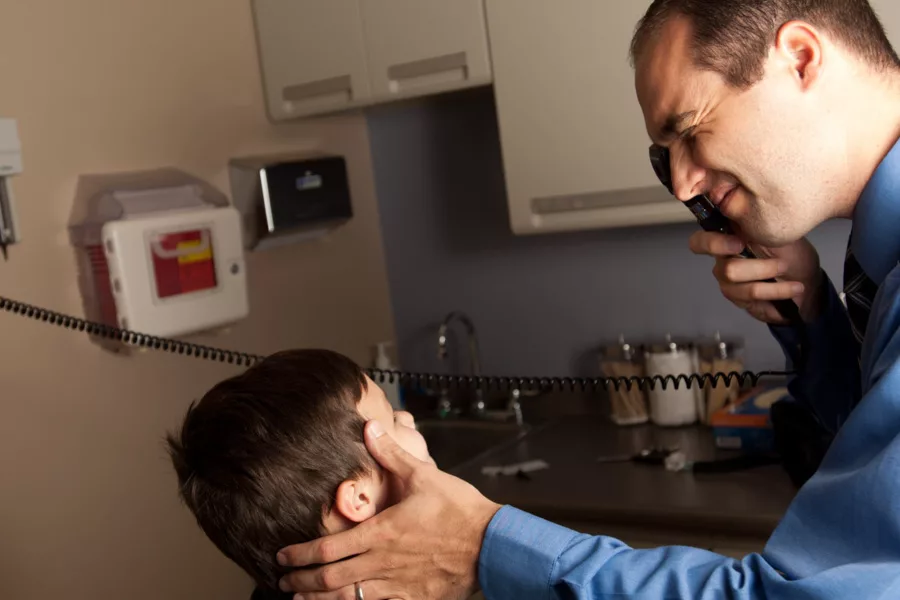
Home » The doctor won’t see you now – but maybe in a few months
The doctor won’t see you now – but maybe in a few months
Physician shortage means long wait times, burden on health care workers

Shortages of primary care providers lead to long wait times for patients and increased burden on health care facilities. Dr. Aaron Richardson works with a patient.
Courtesy KadlecOctober 14, 2024
The Tri-Cities area, like the rest of the nation, suffers from a shortage of physicians, leading to long wait times for appointments and an increased burden on health care workers.
Combined, the Benton and Franklin counties had 2.77 licensed physicians per 1,000 residents in 2023, according to data from Benton-Franklin Trends. That’s compared to 4.37 throughout Washington state.
The two counties saw different numbers, too: Benton County had 3.53 licensed physicians per 1,000 residents, compared to Franklin County’s 1.16.

Micheal Young
Particularly pronounced is the shortage of primary care providers, who frequently provide patients with access to all other parts of the health care system.
“Patients need access to care,” said Micheal Young, the vice president of operations east at Yakima Vally Farm Workers Clinic, locally known as Miramar Health Center, located in Kennewick. “We can’t offer support and increase patient outcomes and health if they can’t get in to see the providers they need to. So we’ve got to find a way to support our patients and our community. And as our community grows, it’s going to be even more important.”
The challenges
At Kennewick’s Trios Health and Pasco’s Lourdes Health clinics, it can take months to see a primary care provider, said Emilia Keener, market senior director of physician services.
Wait times for new patients can be between three and six months at Kadlec clinics, said Rob Watilo, chief operating officer, Kadlec Medical Group.
It’s difficult for patients to get access, and particularly hard for new patients to establish care, Young said.

Rob Watilo

Dr. Richard Meadows
Long waits can result in late diagnoses and prescriptions that have run out months ago, said Dr. Richard Meadows, chief medical officer, Kadlec Medical Group.
By the time a patient gets in to see their primary care provider, they may have a large list to address during a short appointment slot, putting pressure on the provider, Meadows said.
Patients with immediate needs can go to an urgent care location, Keener said, but they can end up filling up emergency departments.
“There are more people who show up at urgent cares and ERs for things that really don’t belong there,” Meadows said. “They belong in a primary care clinic, but because there’s no access, you do the best you can as a patient to get the care that you need.”
When patients can’t get an appointment, they may leave messages or go to an urgent care, creating more work for primary care providers and their teams, Young said.
“Somehow it ends up still circling back to the primary care provider, even if it’s not on their schedule,” he said.

Emilia Keener
The impacts trickle down to specialists, who may end up filling in for primary care providers, Meadows said. Once a patient gets an appointment to follow up on specialty-based care, they might ask for things their primary care provider would normally handle, like medication management.
That means specialists are handling tasks outside of their scope of work, and it may generate longer wait times for the patients only a specialist can see.
“Primary care doctors are the foundation of any health care facility,” Keener said, and that makes a shortage of these providers particularly difficult.
Growing gap
Tri-City health care clinics saw a number of different reasons for the physician shortage.
One factor is the sheer length of time it takes to become a physician, between 12 and 16 years, Keener said.
As the older generation of doctors ages out, “not as many primary care doctors are coming up through the rank and file,” she said.
Another factor is the growth in the Tri-Cities. “As our community has grown so much and continues to grow, our demand for providers, both primary care and specialty, continues to grow,” Young said.
Benton County’s population, currently 217,850, has increased 5.3% since 2020, according to state population data. Franklin County’s population has increased 5.7% to 102,300 over the same period.
Health care providers in the region are doing their best to meet the demand, Young said, but “if there’s already a shortage and then you tack on a higher growth rate, that can make it more difficult.”
Another difficulty is the Tri-Cities’ location.
Since there is a growing gap between the number of physicians and how many are needed across the country, graduating physicians have many jobs available to them, Meadows said.
Urban areas, he said, might mean a physician spends less time on call, or there might be more opportunities for a spouse to find a job. More rural areas might offer loan repayment.
At a medical center like Kadlec, Meadows said, physicians are likely to be on call more often and there isn’t loan forgiveness. “People weigh those things,” he said.
Reducing the burden
One way Tri-City health care clinics are addressing the shortage of primary care providers is by helping to alleviate the burden placed on current providers.
“I think really the big burden on primary care is just all the paperwork and all the things that you have to do,” Keener said.
Lourdes, Trios and Kadlec support their physicians through advanced practice providers, or what Keener calls “physician extenders.”

Shortages of primary care providers lead to long wait times for patients and increased burden on health care facilities. Dr. Aaron Richardson works with a patient.
| Courtesy KadlecThat category includes nurse practitioners, physician assistants, midwives and nurse anesthetists, who take on some of the roles typically covered by physicians.
That could include following up with the patient, answering questions and helping to educate the patient, Keener said.
At Kadlec, the advanced practice providers are also in a call group with a physician. The physician will still have to be on call, Meadows said, but “you have a partner to do that with.”
Similarly, nurse navigators at Trios and Lourdes help primary care doctors with follow-ups on chronic care, emergency department visits and transitional care management.
In the last 18 months, Yakima Valley Farm Workers Clinic has begun offering scribes to its providers. That helps “ease some of the documentation and burden of notes from the providers,” Young said.
With someone else taking notes while the doctor talks to their patient, the providers can “refocus their efforts back to the patient,” he said.
Yakima Valley Farm Workers Clinic also has dieticians and behavioral health consultants which can help patients with more specific needs.
“By adding additional resources … it’s much more fulfilling for the primary care providers, much more sustainable,” Young said.
Likewise, Meadows said that having hospital-based programs at Kadlec helps primary care providers focus on their patients instead of doing hospital admissions.
Meadows said that Federally Qualified Health Centers, or FQHCs, like Yakima Valley Farm Workers Clinic, Tri-City Community Health and Columbia Basin Health, help to take on more Medicaid patients as well.
To keep up with the community’s growth, Kadlec is planning to break ground on a new medical office building next to its current West Richland clinic at 3950 Keene Road in 2025. That expansion will create enough space to add 10 additional primary care providers.
The next generation
Training the next generation of physicians is also key to addressing the shortfall.
Yakima Valley Farm Workers Clinic, Kadlec, Trios and Lourdes all have residency programs that allow newly graduated medical school graduates to gain hands-on experience in their chosen medical specialty.
Residencies are key to bringing young people into the field. “This is a very good way to keep physicians in the area,” Keener said.
Nearly 70% of residents in either the family or internal medicine programs at Trios and Lourdes have stayed in the region, and 17% have stayed in the Tri-Cities since the first class graduated in 2016.
Yakima Valley Farm Workers Clinic offers two residencies as well, one for family practice physicians and one for nurse practitioners.
“It’s really helpful to kind of train our own,” Young said. “… And then obviously we hope to recruit and retain those into our system as well.”
Kadlec’s family practice residency program, which graduated its seventh class last year, has the highest retention rate of residents among the Providence system, Watilo said.
About three or four of the eight residents per year stay on either at Kadlec or in the community.
“For us, that’s been a pretty successful strategy,” he said.
Kadlec also has a program that allows high school students to explore the field of health care, and health care students in college at Washington State University Medical School and Pacific Northwest University of Health Sciences do clinical rotations at Kadlec.
“That return on investment is years down the road, but that’s how you have to think, right? You have to start that early to keep a pipeline going,” Meadows said.
Latest News Local News Health Care
KEYWORDS October 2024
Related Articles
Related Products





